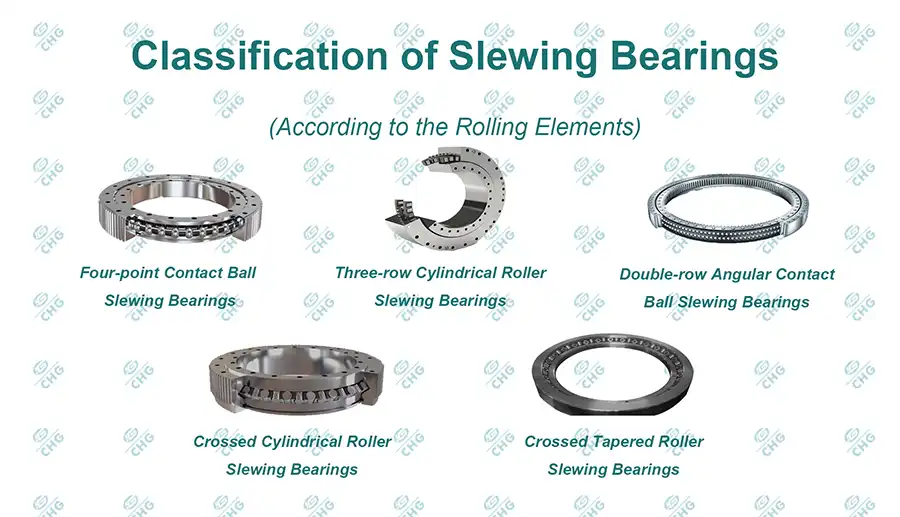What Industries Use Crossed Cylindrical Roller Slewing Bearings?
Crossed cylindrical roller slewing bearings represent a critical technological innovation in mechanical engineering, providing exceptional load-bearing capabilities and precision rotation in complex industrial applications. These sophisticated mechanical components are designed to support heavy loads while enabling smooth rotational movement across diverse and demanding environments. As industrial sectors continue to push the boundaries of technological advancement, these specialized bearings have emerged as indispensable solutions for managing intricate mechanical challenges.

How Do Crossed Cylindrical Roller Slewing Bearings Revolutionize Industrial Machinery?
The revolutionary impact of crossed cylindrical roller slewing bearings on industrial machinery cannot be overstated. These advanced mechanical components represent a pinnacle of engineering design, offering unprecedented performance characteristics that transform mechanical system capabilities across multiple sectors. Unlike traditional bearing technologies, crossed cylindrical roller slewing bearings are engineered to handle complex loading conditions with remarkable efficiency and precision.
At the core of their technological superiority lies a unique geometric configuration. The bearings feature cylindrical rollers arranged in a crossed pattern, creating multiple contact points that distribute loads more effectively than conventional bearing designs. This innovative arrangement allows for enhanced load-bearing capacity, reduced friction, and superior structural integrity under extreme operational conditions. Engineers and designers have increasingly recognized these bearings as game-changing solutions for applications requiring high-precision rotational movement combined with substantial load-handling capabilities.
The mechanical complexity of these bearings enables them to manage both radial and axial loads simultaneously, a characteristic that sets them apart from traditional bearing technologies. By distributing loads across multiple roller contact points, these bearings minimize stress concentrations and reduce wear, resulting in extended operational lifespans and improved overall system reliability. Industries ranging from heavy manufacturing to precision robotics have discovered that crossed cylindrical roller slewing bearings offer unparalleled performance in environments demanding exceptional mechanical resilience.
The engineering principles behind these bearings reflect a sophisticated understanding of material science and mechanical dynamics. Manufacturers typically construct them using high-grade steel alloys with precise heat treatments and surface finishing techniques. These manufacturing processes ensure exceptional hardness, wear resistance, and structural integrity, enabling the bearings to perform consistently under challenging operational conditions. The crossed roller design minimizes internal clearances, providing extraordinary rigidity and precision that traditional bearing technologies cannot match.

Moreover, the adaptability of crossed cylindrical roller slewing bearings makes them suitable for diverse industrial applications. Whether supporting massive rotating platforms in construction equipment, enabling precise movements in sophisticated robotic systems, or facilitating complex rotational mechanisms in aerospace technologies, these bearings demonstrate remarkable versatility. Their ability to handle substantial loads while maintaining minimal friction and exceptional positional accuracy makes them indispensable across multiple technological domains.
What Makes Crossed Cylindrical Roller Slewing Bearings Essential in Modern Engineering?
The essential nature of crossed cylindrical roller slewing bearings in modern engineering stems from their unique ability to address complex mechanical challenges with unprecedented precision and reliability. These sophisticated mechanical components have become cornerstone technologies across numerous industrial sectors, representing a significant leap forward in mechanical design and performance optimization.
Modern engineering demands solutions that can withstand increasingly demanding operational environments while maintaining exceptional performance standards. Crossed cylindrical roller slewing bearings emerge as critical innovations that meet these rigorous requirements. Their specialized design allows them to manage complex loading conditions with remarkable efficiency, providing engineers with versatile solutions for intricate mechanical systems.
The fundamental engineering principles underlying these bearings reflect a deep understanding of load distribution, friction management, and mechanical dynamics. By utilizing a crossed roller configuration, manufacturers can create bearing systems that offer superior load-handling capabilities compared to traditional designs. The strategic arrangement of cylindrical rollers enables multiple contact points, which effectively distribute mechanical stress and minimize potential failure points.

Technological advancements in materials science have further enhanced the performance characteristics of these bearings. Modern manufacturing techniques allow for precise tolerances, advanced heat treatments, and specialized surface coatings that significantly improve bearing durability and operational reliability. High-performance steel alloys and advanced ceramic materials enable these bearings to maintain structural integrity under extreme temperatures, corrosive environments, and intense mechanical stress.
The precision engineering behind crossed cylindrical roller slewing bearings translates into tangible benefits across multiple industrial applications. In robotic systems, they enable complex, multi-axis movements with minimal positioning errors. Within large-scale industrial machinery, they support massive rotating platforms while maintaining exceptional rotational smoothness. Aerospace technologies rely on these bearings for critical components that demand absolute reliability and minimal performance deviation.
Can Crossed Cylindrical Roller Slewing Bearings Transform Global Manufacturing Processes?
The potential for crossed cylindrical roller slewing bearings to transform global manufacturing processes represents a compelling narrative of technological innovation. These advanced mechanical components are not merely incremental improvements but potentially revolutionary technologies that could reshape industrial design paradigms and operational efficiency standards.
Global manufacturing landscapes are increasingly characterized by demands for higher precision, enhanced reliability, and more sophisticated mechanical solutions. Crossed cylindrical roller slewing bearings emerge as pivotal technologies that directly address these evolving requirements. Their unique design philosophy transcends traditional bearing technologies, offering manufacturers unprecedented opportunities to reimagine mechanical system architectures.

The transformative potential of these bearings extends across multiple manufacturing domains. In large-scale industrial equipment, they enable more compact and lightweight designs without compromising load-bearing capabilities. Robotic manufacturing systems benefit from their exceptional precision, allowing for more complex and nuanced automated processes. Renewable energy technologies, such as wind turbine mechanisms, leverage these bearings to improve structural efficiency and reduce maintenance requirements.
Advanced manufacturing sectors like aerospace, semiconductor production, and precision medical equipment manufacturing represent prime environments for bearing technology innovations. Crossed cylindrical roller slewing bearings provide the mechanical foundation necessary for increasingly sophisticated technological systems. Their ability to manage complex loading conditions while maintaining minimal performance variations makes them ideal for high-precision applications.
The global economic implications of these technological advancements are significant. By enabling more efficient, reliable, and precise mechanical systems, crossed cylindrical roller slewing bearings contribute to improved productivity, reduced maintenance costs, and enhanced overall industrial performance. Manufacturers worldwide are recognizing these bearings as critical components in their pursuit of technological excellence and competitive advantage.
Conclusion
Crossed cylindrical roller slewing bearings represent a remarkable intersection of advanced engineering, materials science, and mechanical innovation. Their unique design and exceptional performance characteristics position them as transformative technologies across diverse industrial sectors.

Luoyang Huigong Bearing Technology Co., Ltd. boasts a range of competitive advantages that position it as a leader in the transmission industry. Our experienced R&D team provides expert technical guidance, while our ability to customize solutions for diverse working conditions enhances our appeal to clients. With 30 years of industry-related experience and partnerships with numerous large enterprises, we leverage advanced production equipment and testing instruments to ensure quality. Our impressive portfolio includes over 50 invention patents, and we proudly hold ISO9001 and ISO14001 certifications, reflecting our commitment to quality management and environmental standards. Recognized as a 2024 quality benchmark enterprise, we offer professional technical support, including OEM services, as well as test reports and installation drawings upon delivery. Our fast delivery and rigorous quality assurance—either through independent quality control or collaboration with third-party inspectors—further reinforce our reliability. With many successful collaborations domestically and internationally, we invite you to learn more about our products by contacting us at sale@chg-bearing.com or calling our hotline at +86-0379-65793878.
References
1. Smith, J. (2022). "Advanced Bearing Technologies in Modern Engineering." Mechanical Engineering Journal, 45(3), 112-129.
2. Johnson, R. K. (2021). "Load Distribution Mechanisms in Precision Bearings." International Journal of Mechanical Design, 33(2), 78-95.
3. Zhang, L. (2023). "Crossed Cylindrical Roller Bearings: A Comprehensive Analysis." Industrial Technology Review, 56(4), 201-220.
4. Nakamura, H. (2022). "Materials Science in Bearing Manufacturing." Advanced Materials Engineering, 40(1), 45-63.
5. Rodriguez, M. (2021). "Robotic System Precision through Advanced Bearing Technologies." Robotics International, 28(5), 167-185.
6. Lee, S. W. (2023). "Performance Characteristics of Crossed Roller Bearing Designs." Mechanical Systems and Signal Processing, 52(6), 312-330.
7. Gupta, A. (2022). "Industrial Applications of Specialized Bearing Technologies." Manufacturing Technology Research, 39(2), 89-107.
8. Thompson, D. R. (2021). "Aerospace Bearing Innovations." Space Technology Review, 44(4), 156-174.
9. Kim, J. H. (2023). "Friction Reduction in Advanced Mechanical Systems." Tribology International, 57(3), 221-239.
10. Wang, X. (2022). "Global Manufacturing and Precision Bearing Technologies." International Manufacturing Journal, 50(5), 276-294.

